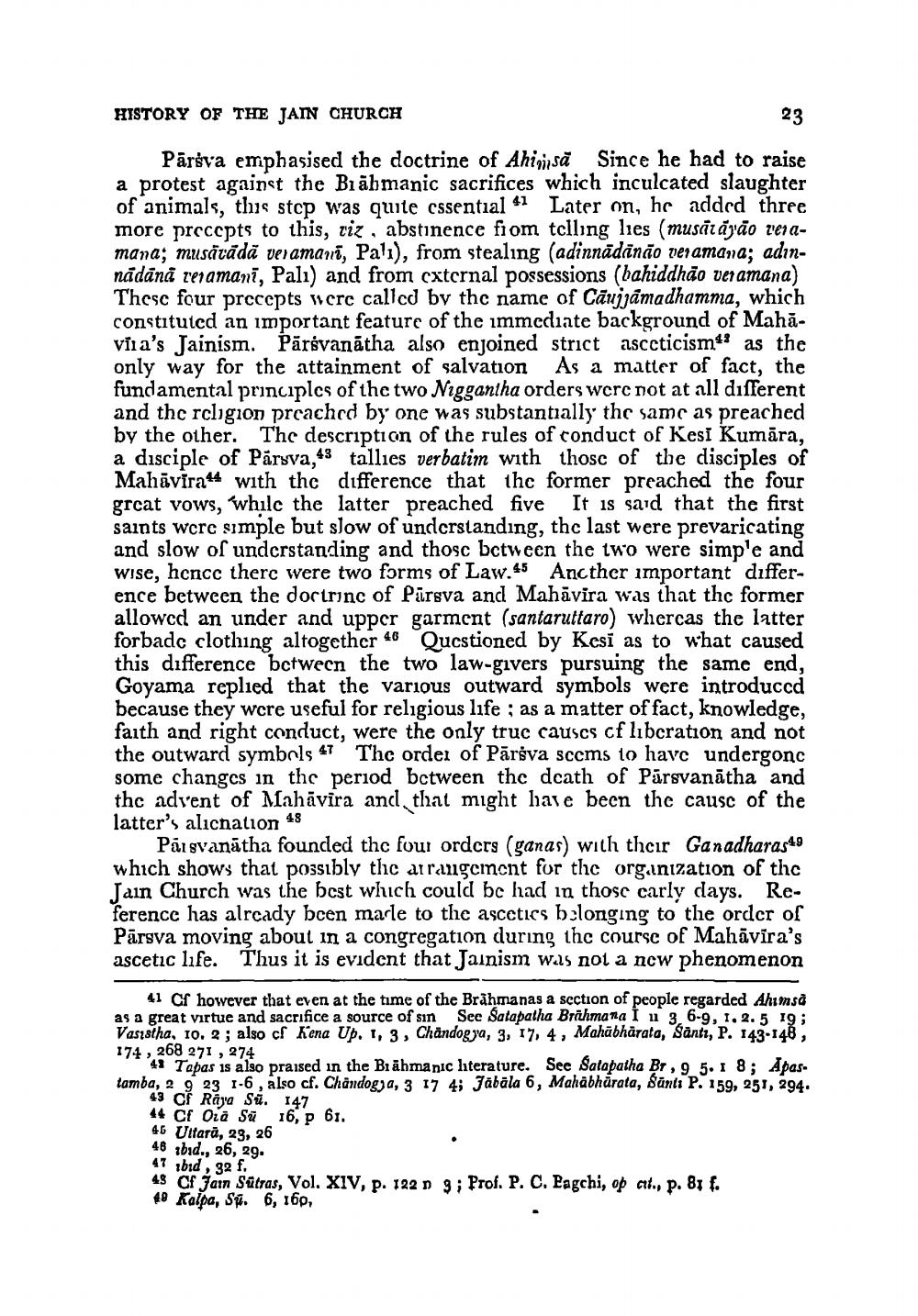________________
HISTORY OF THE JAIN CHURCH
23
Pārsva emphasised the doctrine of Ahinsă Since he had to raise a protest against the Biābmanic sacrifices which inculcated slaughter of animals, this stop was quite cssential 41 Later on, he added three more prcccpts to this, riz, abstinence from tclling lies (musītāyāo zenamana; musätādā veramanī, Palı), from stealing (adinnādānão veramana; adınnädānå reramanī, Palı) and from external possessions (bahiddhão ver amana) Thesc four precepts were called by the name of Cāujjamadhamma, which constituted an important feature of the immediate background of Mahăvila's Jainism. Pārsvanātha also enjoined strict asccticism as the only way for the attainment of salvation As a matter of fact, the fundamental principles of the two Niggantha orders were not at all different and the rcligion proached by one was substantially the same as preached by the other. The description of the rules of conduct of Kesi Kumāra, a disciple of Pārsva,43 tallies verbatim with those of the disciples of Mahāvira44 with thc difference that the former preached the four grcat vows, whilc the latter preached five It is said that the first saints were simple but slow of understanding, thc last were prevaricating and slow of understanding and thosc between the two were simple and wise, hence there were two forms of Law.45 Ancther important difference between the doctrine of Parsva and Mahāvira was that the former allowed an under and upper garment (santaruttaro) whercas the latter forbadc clothing altogether 46 Questioned by Kesi as to what caused this difference betwecn the two law-givers pursuing the same end, Goyama replied that the various outward symbols were introduced because they were useful for religious life ; as a matter of fact, knowledge, faith and right conduct, were the only truc causcs cf libcration and not the outward symbols 47 The order of Pārsva scems to have undergonc some changes in the period between the death of Pārsvanātha and the advent of Mahāvira and that might have been the cause of the latter's alicnation 48
Pārsvanātha founded the four orders (ganas) with their Ganadharas49 which shows that possibly thic arrangement for the organization of thc Jain Church was the best which could be had in those carly days. Reference has already bcen marle to the ascetics belonging to the order of Pārsva moving about in a congregation during the course of Mahāvira's ascetic life. Thus it is evident that Jainism was not a new phenomenon
41 Cf however that even at the time of the Brāhmanas a section of people regarded Ahimsa as a great virtue and sacrifice a source of sin See Satapatha Brahmara I u 3. 6-9, 1. 2. 5 19; Vasistha, 10. 2; also cf Kena Up. 1, 3, Chandog ya, 3, 17, 4, Mahābhārata, Santi, P. 143-148, 174 , 268 271, 274
41 Tapas is also praised in the Brahmanic literature. See Salapatha Br ,9 5. I 8; Apas. tamba, 2 0 23 1-6, also cf. Chandog, a, 3 17 4; Jābāla 6, Mahabharata, Santa P. 159, 251, 294.
43 Cf Rara Sa. 147 44 Cf Ora Su 16, p 61. 46 Uttara, 23, 26 46 ibid., 26, 29. 47 bid , 32 f. 49 Cf Jain Satras, Vol. XIV, p. 122 9; Prof. P. C. Bagchi, op al., p. 81 f. 49 Kalpa, S. 6, 16p,




